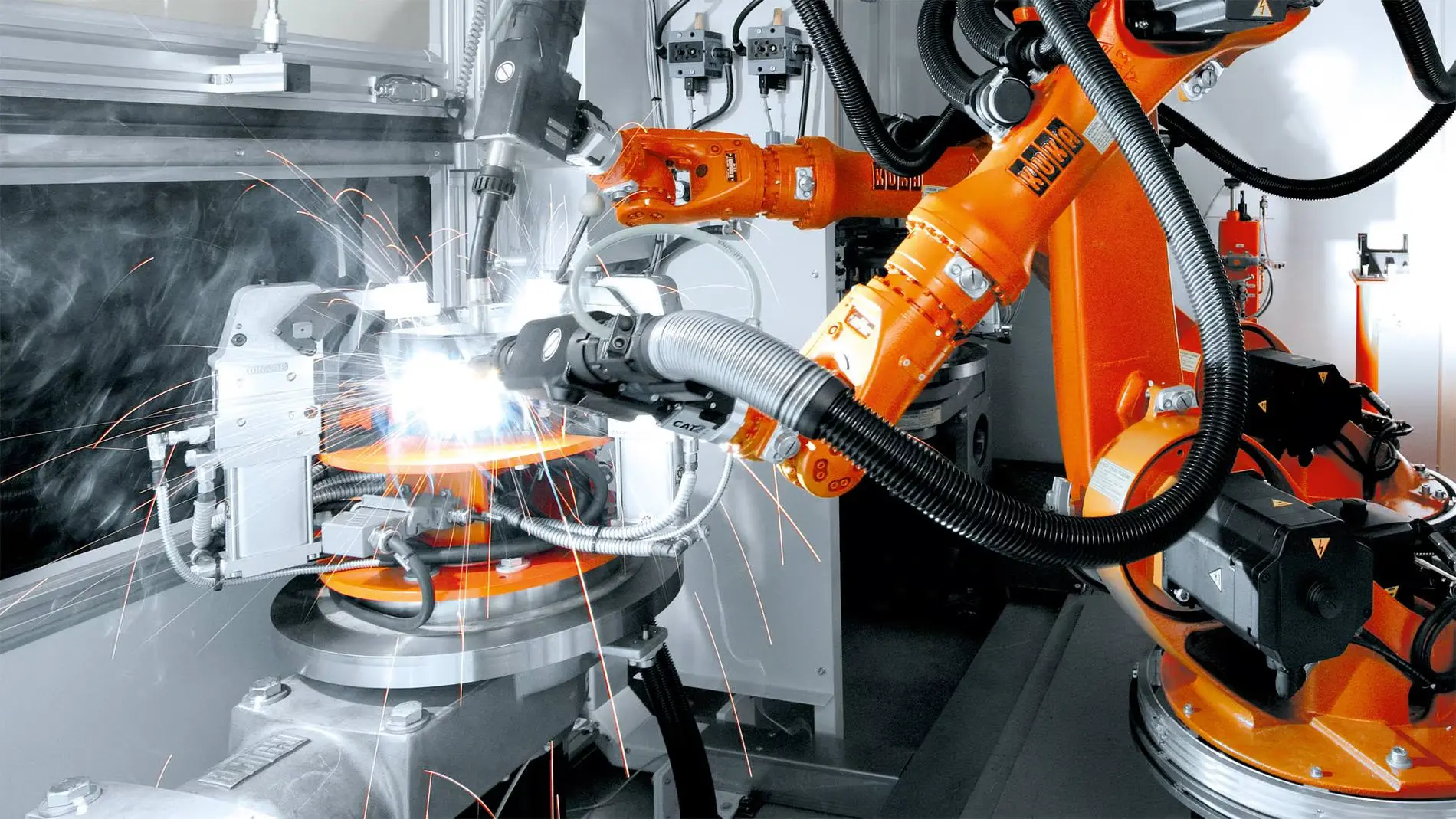Varilna industrija se zaradi pojava robotike in avtomatizacije močno spreminja. Te tehnologije revolucionarno spreminjajo način izvajanja varilnih postopkov, saj prinašajo doslej nepoznano raven učinkovitosti, natančnosti in varnosti. Ta članek obravnava prihodnost avtomatizacije pri varjenju ter se osredotoča na prednosti, izzive in inovacije, ki spodbujajo te spremembe.
Vzpon robotskega varjenja
Robotski varilni sistemi se v industriji vedno bolj uveljavljajo. Ti sistemi vključujejo uporabo robotov za avtomatizacijo postopka varjenja, kar zmanjšuje potrebo po ročnem posredovanju. K vse večji uporabi robotskega varjenja prispeva več dejavnikov:
1. Večja učinkovitost: Roboti lahko delujejo neprekinjeno, brez prekinitev, kar znatno poveča produktivnost. Prav tako lahko izvajajo ponavljajoča se opravila s stalno hitrostjo in natančnostjo, kar je za človeške varilce velik izziv pri dolgotrajnem delu.
2. Povečana natančnost: Robotski varilni sistemi so opremljeni z naprednimi senzorji in nadzornimi algoritmi, ki zagotavljajo visoko natančnost in doslednost zvarov. To zmanjšuje verjetnost napak in predelav, kar vodi k višji kakovosti izdelkov.
3. Izboljšana varnost: Varjenje vključuje izpostavljenost visokim temperaturam, škodljivim dimom in močni svetlobi, kar predstavlja tveganje za varilce. Te nevarne naloge lahko opravljajo roboti, s čimer se zmanjša izpostavljenost ljudi ter tveganje za nesreče in poškodbe.
4. Prihranki stroškov: Čeprav je začetna naložba v robotske varilne sisteme lahko visoka, so dolgoročni prihranki pri stroških precejšnji. Manjši stroški dela, manjša izguba materiala in manj ponovnih del sčasoma prispevajo k znatnim prihrankom.
Ključne komponente robotskih varilnih sistemov
1. Robotske roke: Robotska roka je osrednja komponenta, zasnovana tako, da posnema gibe človeške roke, vendar z večjo natančnostjo in ponovljivostjo. Te roke so običajno opremljene z varilnimi gorilniki in različnimi senzorji.
2. Krmilniki: Krmilniki upravljajo delovanje robotske roke, zagotavljajo natančno gibanje in usklajevanje z drugimi sestavnimi deli sistema. Napredne krmilnike je mogoče programirati za izvajanje zapletenih nalog varjenja in prilagajanje spremembam v varilnem okolju.
3. Viri energije za varjenje: Vir energije zagotavlja potrebno energijo za varjenje. Sodobni sistemi pogosto uporabljajo inverterske vire energije, ki omogočajo boljši nadzor nad varilnimi parametri in so energetsko učinkovitejši.
4. Senzorji in kamere: Senzorji in kamere so bistvenega pomena za spremljanje procesa varjenja v realnem času. Pomagajo zaznati morebitna odstopanja od želenih parametrov in sistemu omogočajo sprotne prilagoditve.
5. Programska oprema: Za programiranje in nadzor robotskih varilnih sistemov se uporabljajo napredne programske rešitve. Ta programska orodja omogočajo načrtovanje poti, nastavljanje parametrov in spremljanje v realnem času, kar zagotavlja optimalno delovanje.
Inovacije, ki spodbujajo robotsko varjenje
Številne inovacije premikajo meje, ki jih lahko dosežejo robotski varilni sistemi:
1. Umetna inteligenca (AI) in strojno učenje (ML): V robotske varilne sisteme se vgrajujeta umetna inteligenca in večpredstavnost, da se izboljšajo njihove zmogljivosti. Te tehnologije robotom omogočajo, da se učijo iz prejšnjih varilnih nalog, optimizirajo parametre in predvidijo morebitne težave, še preden se pojavijo.
2. Sodelujoči roboti (Cobots): Coboti so zasnovani tako, da delajo skupaj s človeškimi varilci in združujejo prednosti obeh. Lahko opravljajo ponavljajoča se opravila, medtem ko se človeški varilci osredotočajo na kompleksnejša in zapletenejša dela, kar izboljša splošno učinkovitost in prilagodljivost.
3. Dodajalna proizvodnja: Dodajalna proizvodnja ali 3D tiskanje se združuje z robotskim varjenjem, kar ustvarja nove možnosti pri izdelavi kompleksnih sestavnih delov. Ta hibridni pristop omogoča izdelavo delov po meri z minimalnimi izgubami materiala.
4. Napredni senzorji in vidni sistemi: Z razvojem naprednejših senzorjev in vidnih sistemov se izboljšuje sposobnost robotskih varilnikov, da se prilagajajo različnim pogojem in materialom. Ti sistemi zagotavljajo podrobne povratne informacije, kar omogoča prilagoditve v realnem času in zagotavlja visoko kakovost zvarov.
Izzivi pri robotskem varjenju
Kljub številnim prednostim so z uvajanjem robotskih varilnih sistemov povezani tudi izzivi:
1. Visoki začetni stroški: Začetni stroški nakupa in namestitve robotskih varilnih sistemov so lahko visoki, zlasti za mala in srednje velika podjetja. Vendar pa dolgoročne koristi pogosto upravičijo naložbo.
2. Kompleksnost integracije: Vključevanje robotskih varilnih sistemov v obstoječe proizvodne linije je lahko zapleteno. Zahteva skrbno načrtovanje in usklajevanje, da se zagotovi nemoteno delovanje in združljivost z drugo opremo.
3. Usposobljena delovna sila: Upravljanje in vzdrževanje robotskih varilnih sistemov zahteva usposobljeno delovno silo s strokovnim znanjem s področja robotike, avtomatizacije in varjenja. Programi usposabljanja in razvoja so bistvenega pomena za oblikovanje in ohranjanje takšne delovne sile.
4. Prilagodljivost: Čeprav so robotski sistemi zelo učinkoviti pri ponavljajočih se opravilih, pa jim lahko primanjkuje prilagodljivosti človeških varilcev pri opravljanju naročenih ali enkratnih opravil. Napredek na področju programiranja in umetne inteligence to omejitev odpravlja, vendar ostaja pomemben dejavnik.
Prihodnost robotskega varjenja
Prihodnost robotskega varjenja je obetavna, saj tehnologija nenehno napreduje in se vse bolj uveljavlja v različnih panogah. Nekateri trendi, ki jih je treba spremljati, vključujejo:
1. Večja integracija umetne inteligence: Z razvojem tehnologije umetne inteligence bo njena integracija v robotske varilne sisteme vse bolj izpopolnjena, kar bo omogočilo pametnejše in bolj prilagodljive robote, ki bodo sposobni opravljati več različnih nalog.
2. Večja uporaba robotov: Pričakuje se, da bo uporaba sodelujočih robotov naraščala, zlasti v okoljih, kjer sta prožnost in sodelovanje med človekom in robotom ključnega pomena. Koboti bodo imeli ključno vlogo pri povečanju produktivnosti in varnosti.
3. Širitev v nove panoge: Avtomobilska in letalska industrija sta bili zgodnji podjetji, vendar se robotsko varjenje uveljavlja tudi v drugih sektorjih, kot so gradbeništvo, ladjedelništvo in obnovljivi viri energije. Ta trend se bo nadaljeval, saj so prednosti avtomatizacije vse bolj prepoznavne.
4. Okrepljena povezljivost in internet stvari: Integracija tehnologij interneta stvari (IoT) bo omogočila boljšo povezljivost in izmenjavo podatkov med robotskimi varilnimi sistemi in drugo industrijsko opremo. To bo omogočilo učinkovitejše spremljanje, vzdrževanje in optimizacijo procesa varjenja.
Zaključek
Robotsko varjenje spreminja varilsko industrijo, saj omogoča znatno izboljšanje učinkovitosti, natančnosti in varnosti. Čeprav je treba premagati še nekatere izzive, so prednosti avtomatizacije očitne in prihodnost te tehnologije je svetla. Z razvojem napredka na področju umetne inteligence, kobotov in interneta stvari bodo robotski varilni sistemi postali še bolj zmogljivi, kar bo spodbudilo inovacije in produktivnost v industriji.

